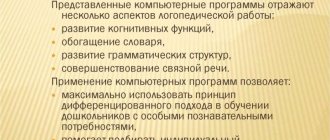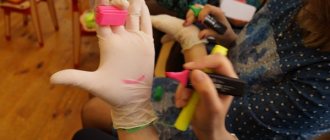Age restrictions for the use of myocorrection
Gymnastics for the correction of disorders of the dentoalveolar system is used when working with children aged 4-8 years, during the period of primary occlusion. If developmental anomalies are mild, then 2-3 months of training is sufficient. A positive effect can be achieved during the period of teeth change at the age of 9-12 years. During this period, the jaw is not yet fully formed and can be corrected. In later periods, the effect of therapy is minimal and requires a very long period of use (more than a year), so myofunctional exercises are not prescribed.
Trainers Myobrace
Myobrace trainers are manufactured by Myofunctional Research Co. Customized Myobrace trainers, available in different sizes, have found their use as devices for myofunctional training, as well as retention equipment for fixing the bite after removing braces. Often used as devices before wearing braces to widen the jaws and straighten teeth. Used in children 8-15 years old.
The timing and pattern of wearing myofunctional trainers for teeth and vestibular plates is determined by the doctor.
In order to start treatment on time, you just need to show your child to the pediatric dentist once every six months after the first teeth erupt. If the doctor notices a problem, he will recommend a consultation with a pediatric orthodontist. Often, a child needs accompanying supervision from specialists such as an ENT doctor, speech therapist, osteopath, or child psychologist.
Make an appointment for a consultation by phone +7-499-110-18-01 or through the form on the website. You can ask questions about correcting your bite to the chief doctor of the clinic, Sergei Vladimirovich Tsukor, at
Indications and contraindications for the use of myofunctional therapy
Myofunctional correction is prescribed if:
- abnormal bite of the first degree;
- dysfunction of the circular muscles of the tongue and mouth;
- uneven placement of crowns;
- disorders of the temporomandibular joint;
- hypotonicity of the facial muscles.
Contraindications when the use is not justified by the achieved effect include:
- poor jaw mobility;
- hypertrophy of the facial muscles;
- third degree abnormal bite;
- visible restrictions of mobility in the temporomandibular joints;
- abnormal jaw growth due to previous diseases.
The first signs of disorders of the dental system
The need to use myofunctional correction arises if the following conditions are recorded:
- breathing occurs primarily through the mouth;
- swallowing requires strong tension of the jaw muscles;
- speech defects appear;
- baby sucks thumb;
- the child has no gaps between primary teeth;
- An uncontrollable state of biting nails or pencil occurs.
Any of these conditions indicates the need for myofunctional correction to timely block disorders of the dentofacial system.
Symptoms
It is very important to detect in time the signs that the infantile type of swallowing still predominates in an older child, the tongue does not “stick” to the upper palate, and he breathes mainly through the mouth rather than the nose. These developmental disorders can be judged, in particular, by their posture - when the child stands upright, his arms are not at the seams, but lean forward. The head is also pushed forward. When swallowing, children move their heads even further forward to ensure air flow. Pay attention to dark circles under the eyes - they also often indicate that the child has a lower tongue and breathes through his mouth. And, of course, if the mouth is slightly open during sleep, even if the gap is only 1-3 millimeters, this is an obvious sign of the disorders described above, unless, of course, the person currently has a runny nose.
The main causes of violations
Experts note that disorders of facial and masticatory muscles arise due to disruptions in the functioning of the body. The development of these disorders is facilitated by:
- prolonged feeding on soft and pureed food, drinking from a bottle with a nipple leads to disruption of the development of swallowing function;
- the lack of solid food provokes slower growth of the jaws and incorrect formation of the position of the teeth, which causes malocclusion;
- Excessive use of pacifiers or thumb sucking contributes to deformation of the jaw bones;
- poor posture affects myodynamic balance;
- genetic predisposition;
- incorrect articulation contributes to speech disorders;
- Frequent colds provoke the development of mouth breathing and weakening of nasal breathing.
Moneybox of knowledge
Exercises to normalize nasal breathing
Exercise 1. Air massage of the nasal mucosa. Feet to the sides, mouth tightly closed, slowly inhale air alternately through the right and left nostrils, alternately pressing the opposite nostril with your fingers.
Exercise 2. “Start the car” Long pronouncement of the sound “D-D-D” (30 sec)
Exercise 3. “The ball burst.” Puff out your cheeks and slowly squeeze out air through pursed lips.
Exercise 4. With your lips open, place your little fingers on the corners of your mouth in this position and try to close your lips.
Speech therapy massage is one of the methods of correctional and pedagogical influence used in the correction of severe speech disorders. This is an unconventional and effective method of correcting sound pronunciation, because Speech therapy massage helps to normalize the pronunciation side of speech, improves the condition of the voice, speech breathing, and normalizes the emotional state of a person suffering from speech disorders.
Consultation with an osteopath in Zelenograd.
An osteopath gets to know the problem that concerns you. And then, with the help of osteopathic techniques, he finds out the possibility of solving the problem. The most commonly used technique is Craniosacral Therapy.
Great idea for a breathing machine.
The effect of using myofunctional therapy
To achieve a therapeutic effect, it is necessary not only to follow all recommendations for performing the selected exercises, but also to correctly determine the degree of anomaly in the development of the defect. With timely and correct prescription of myofunctional exercises, the following occurs:
- restoration of the performance of the maxillofacial muscles;
- normalization of the tone of facial and chewing muscles;
- elimination of speech defects;
- improved posture;
- restoration of the process of swallowing and breathing;
- formation of chewing skills;
- correct tongue placement.
It is worth remembering that various anomalies require special exercises, which should be prescribed by a specialist after conducting a comprehensive examination of the patient and identifying all possible pathologies and disorders.
Basic rules of myofunctional therapy
Myofunctional exercises must be performed following the basic rules of physical therapy:
- muscle tension occurs smoothly and slowly;
- tension should alternate with relaxation;
- it is necessary to correctly select the load to limit overvoltage;
- the exercise is performed several times until you feel slightly tired;
- classes must be conducted regularly;
- The duration of the exercises and the speed of their execution should gradually increase.
By observing these provisions, it is possible to rebuild the work of muscles and correct the development of the skeleton towards anatomical balance. The effect is achieved thanks to:
- normalization of functional characteristics;
- biological stimulation of muscle development and bone growth;
- beneficial effect on trophic processes;
- formation of a compensating mechanism.
The main set of myofunctional exercises
Various methods and sets of exercises have been developed to eliminate developmental disorders of the dentofacial system. The main ones include exercises for the following anomalies:
- Deep bite. The exercises are based on moving the lower jaw forward.
- Open bite. The classes are aimed at training the muscles that are responsible for raising the lower jaw.
- Underdevelopment of the orbicularis oris muscle. These exercises are necessary for the development of mouth breathing and disruption of the contours of the mouth opening. Successful training helps prevent the development of relapse of the inclination of the upper incisors.
- Mesial bite. The exercises are aimed at developing the correct position of the jaws.
- Oblique bite. The lessons are based on moving the lower jaw to the side, as well as correcting the closure of teeth.
- Underdevelopment of the tongue muscles. In this case, therapy is carried out depending on the degree of development of the anomaly and includes correction of lip closure, exercises after cutting the frenulum of the tongue, development of the muscles of the front part of the tongue (infantile swallowing), exercises for the middle and back part of the tongue.
- Impaired development of the muscles that protrude the lower jaw. These exercises are aimed at correcting the bite and forming a lip closure.
Article:
Very often, parents turn to a speech therapist with the problem of unclear sound pronunciation in children.
The causes are malocclusion, facial amicability, dysfunction of swallowing and chewing, and predominance of mouth breathing. You can't get by with just a speech therapist. We need the comprehensive work of specialists: an orthodontist, a psychologist, a dentist, a speech therapist, a neurologist, and a physical therapy instructor. What are myofunctional disorders When examined, many children reveal an abnormal structure of the oral cavity: small teeth, distorted bite, the upper jaw protrudes above the lower jaw or vice versa, short frenulum, incorrect position of the tongue at rest, flaccid, non-closed lips (so the mouth is always open) and etc. As a result of the above, the tone of the masticatory and facial muscles decreases or increases, and the process of swallowing and breathing (oral) is disrupted. All this together is called myofunctional disorders (MFDs). Because of them, the child not only has defects in sound pronunciation and “porridge” in the mouth (impaired speech rate, prosody), but also problems with the production and automation of sounds. The use of speech therapy probe massage and articulatory gymnastics in this case is not enough. A broader and more in-depth approach is needed. Causes of myofunctional disorders Genetic – 25%. A short frenulum is often inherited. At the same time, malocclusion can be “inherited” when the pronunciation of the sounds [r], [l], [s], as well as hissing sounds, is distorted. Bad habits: thumb sucking, pacifiers after a year, biting the tongue, lips, cheeks, sticking the tongue out between the teeth. Sucking is not a physiological norm, therefore, by the age of one year, after the appearance of the first teeth, it is not recommended to suck not only a pacifier, a bottle, but also a breast. The sucking process should smoothly transition into a chewing pattern, which will have a beneficial effect on clear sound pronunciation. Sucking activates the brain up to a certain point. Later it may have the opposite effect, even leading to mental retardation. The longer sucking develops, the more complicated the situation with maintaining muscle tone becomes. Thumb sucking causes jaw deformation. Mouth breathing. May occur due to allergic reactions to household chemicals and food. Reactions may be sluggish and characterized by frequent nasal congestion. To get the oxygen needed for the brain, the child begins to breathe through the mouth. Over time, chronic hypoxia develops due to improper functioning of the respiratory system. Even if the child's lips are slightly parted, mixed breathing is established. Infantile swallowing. Is normal for up to one year of life. After the eruption of milk teeth, it is replaced by chewing. Due to the fact that many children are fed crushed food for a long time, an incorrect swallowing pattern is formed, and infantile behavior persists. The chewing process strengthens the chewing muscle of the tongue. Often, as chewing becomes more established, the quality of speech improves. Sluggish sucking and chewing. Recently, it has been rapidly developing due to the emergence of various bags and bottles for suction. This supports infantile swallowing, a lower position of the tongue, which is not the norm in a child of older preschool age. Early removal of baby teeth. Signs of MFN You can understand whether a child has myofunctional disorders or not even by appearance: a slightly open mouth all the time; breathing through the mouth; lip tension when swallowing; the tongue falls out into the interdental space during a conversation; incorrect pronunciation of many sounds; often the distal position of the lower jaw (the upper teeth protrude above the lower teeth), while the lower jaw, together with the position of the tongue, moves towards the pharynx; hypersalivation (salivation), increased salivation; decreased immunity and frequent colds. Babies with MFN have an infantile type of swallowing. When swallowing, the lips move forward, and the muscles that make you nod your neck work. Therefore, hypertonicity of the cervical-collar area very often occurs. Due to the fact that the lower jaw moves posteriorly when swallowing, it partially blocks the airway. Since the body needs oxygen, the child begins to move his head forward. As a result, the ratio of the head and torso changes, the head seems to be suspended. The center of gravity shifts. To support the head, the neck muscles are constantly tense. This tension causes mechanical compression of the vessels that supply the brain and forms chronic hypoxia. Nutrients do not reach the brain fully, and the child’s coordination of movements changes. To support the head, the body shifts forward: the arms are “twisted” forward, the shoulder blades stick out, the spine is curved. To balance his body in space, the child finds a comfortable but incorrect position. Lumbar hyperlordosis develops, the abdominal muscles become weak, and protruded tummy syndrome occurs. Children with MFN do not put their feet in the position that should be normal. Because of this, a valgus or varus condition of the feet is formed. Due to changes in the position of the body in space, the child cannot have good control of his body. Essentially, it's like a child with cerebral palsy. Also, the cause of abnormal bite is disruption of the muscles of the cheeks, tongue, lips, and chin. If the tongue does not work correctly, hypoxia, facial deformation, and flattening of the orbital areas develop. A hypertonic tongue has a high gag reflex. While chewing, it is quite difficult to turn food over and treat it with saliva. The child cannot fully move food in the mouth. With any touch, there is a urge to vomit, and this is unpleasant, so the baby will reflexively avoid it. Will chew with the front of the tongue or grind food on the front teeth. When food is poorly processed by saliva, it enters the stomach in a rather rough state and irritates the mucous membrane, which is why children experience frequent gastrointestinal dysfunction, early gastritis, constipation, and stool disorders. Working with children with myofunctional disorders Children with MFD often experience delayed speech development, dyslalia, and dysarthria. If you seek help only from a speech therapist who begins to work with the organs of the articulatory apparatus, speech problems will not be solved. In this case, you need to carry out competent comprehensive work with several specialists. First of all, it is important to correct the type of swallowing. To do this, you need to visit a myofunctional therapist who will help strengthen the orbicularis oris muscle using trainers, conduct a competent massage of the feet, chest, cervical-collar area, myofascial release, DENS therapy, taping therapy. To restore nasal breathing, you need to consult an ENT doctor. Taping the sinuses will help a lot. It is worth contacting an orthodontist and a pediatric dentist. To eliminate an open bite, experts recommend the use of special vestibular plates (trainers). These are soft silicone tips that regulate the condition of the tongue and normalize the muscular balance of the oral cavity. It is also recommended to use plates with a wire flap (to establish the correct position of the tongue) and with a bead (to warm up the muscles of the tongue before performing articulatory gymnastics). Such plates make the work of a speech therapist easier. Thanks to them, you can create complex sounds. If a speech therapist does not know massage techniques, you can contact a myofunctional massage therapist, neurologist, or exercise therapy instructor. To improve gross motor skills and coordination of movements, specially selected physical exercises are needed. A visit to a psychologist is necessary if, as a result of MFN, there is a delay in mental development and a violation of the emotional-volitional sphere.





